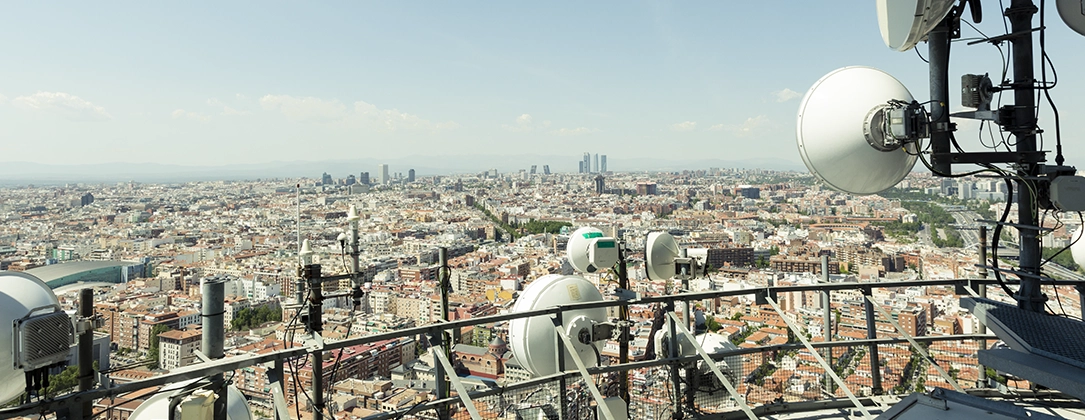Trends
Trends
JUN
07
2022
TIS
Neither a giant nor a windmill, the lollipop celebrates 40 years of life
It is not the giant fancifully imagined by the most famous knight in universal literature, and neither is it the windmill that Sancho insisted on describing to the ingenious nobleman; nevertheless there is something fantastical and emblematic about it.
On Calle O’Donnell in Madrid, crowning the edge of the M-30 motorway, stands a cement and reinforced concrete titan that has become an essential element of the capital’s skyline.
Torrespaña, popularly known as “El Pirulí” (or the lollipop) because of its structure that conjures up a gigantic lollipop, has been disseminating knowledge, dreams, legends and entertainment for forty years by distributing radio and television signals throughout Spain.
The first thing that strikes you as you go into this 220-metre-high architectural umbrella with its 1,208 steps is the somber look of a facility dedicated to service, which has been a landmark in the country’s history and in the development of a telecommunications sector that is a world benchmark.
Access to the control centre located on the third floor – the circular viewing platform in which the structure widens – is via the main lift, which takes almost two minutes to complete the journey (enough time to try to master any vertigo you may be suffering).
In the nerve centre of the building, we are received by Miguel Bonis, head of operations at the tower operated by Cellnex from which telephone, television, radio, internet and emergency frequency signals are collected, sent and forwarded.
Although the container is the same, little or nothing of the content resembles the hundreds of servers and equipment that the tower housed when it was inaugurated in 1982 to meet the enormous demand for broadcasting and news coverage of that analogue football World Cup that put Spain on the map.
“Technology, particularly in the telecommunications sector, has experienced a genuine revolution over these last 40 years. The equipment here today is nothing like the original set-up”, explains Miguel, the proud leader of a group that ensures the 24/7 operation of a basic service for citizens that has exponentially multiplied its audiovisual offer in recent years, has been an exceptional witness to telephony’s Five G’s and has gone from analogue to digital in the blink of an eye.
15 exceptional watchmen
Fifteen professionals from the world of telecommunications and electronics, who know all the tricks of the trade, ensure uninterrupted service from the belly of this tower, compared to other telecommunications structures like the Eiffel Tower in Paris, Berlin’s Fernsehturm or the Ostankino in Moscow.
“One thing that really caught my eye when I came to Torrespaña is the degree of involvement of the staff. The people who work here are acutely aware of the importance of this centre and the repercussions of any possible glitches. We always have someone covering our backs, someone acutely aware that nothing must go wrong”, says Miguel.
This group of custodians ensures the preventive and corrective maintenance of the devices and the renovation of new installations required by technological changes. They are obsessed with providing a robust service and ensuring the effectiveness of numerous redundancies to avoid any service interruption.
“We are driven by a constant desire to improve, based on learning, with the ultimate goal of avoiding zero” explains Miguel, referring to the dreaded interruptions.
In the 40-year history of the tower, TV and radio audiences have hardly suffered any service outages, apart from those caused by a fire that broke out in 2002, which left homes in the Madrid region with no television or radio for three long hours.
“We designed the services in the most robust and fault-resistant way possible and we have redundant systems that automatically kick in if anything fails, but the best way to guarantee the service is by performing constant ongoing maintenance on the equipment”.
Thousands of kilometres of cables run through the enormous structure of a tower crowned by more than 400 antennas in which the stability of the electrical installation plays another priority role.
From its founding function as the broadcasting centre of the public television technical network, Torrespaña joined what was then Abertis Telecom in 2003. Today it is one of Cellnex’s emblems in the field of broadcasting infrastructure in Europe, providing stability and service to the main radio and television stations since the sector was opened up to competition.
Cellnex has promptly adapted the tower’s services to new needs and requirements, stretching from the difficult process of the analogue switch-off and its seamless digital transition to the arrival of high definition, fibre and high-speed telecommunications.
Torrespaña currently generates a radio and television broadcast signal for Madrid and its surrounding area and distributes it from its 360-degree vantage point to centres throughout the country so that 43 television channels, 17 conventional radio stations and 18 digital radio stations can be watched and heard from any corner of the territory.
And yes, sometimes, on windy days, one of the fifteen devoted sentinels seems to feel the giant’s breath, just like the sad knight. A rather less dreamy squire will then produce a home-made pendulum which shows that, despite its ability to withstand winds of up to 200 kilometres per hour, on stormy days the structure can sway by up to 40 centimetres on its axis.
Carlos Ruano
Journalist and Founder of Newsbub





















